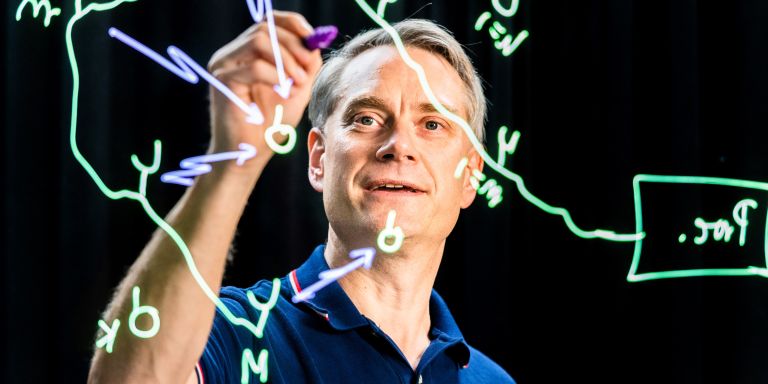
Erik G. Larsson
Professor of Communication Technology
Wallenberg Scholar
Institution:
Linköping University
Research field:
Wireless communication


Wallenberg Scholar
Institution:
Linköping University
Research field:
Wireless communication
Swedish mobile operators opened their 5G networks in spring 2020. Data speeds over the new networks are much higher, and response times much shorter, which allows more services and functions. 5G makes extensive use of Massive MIMO radio technology, which offers a new way of transmitting and receiving radio signals. Larsson, who is a professor at Linköping University, is one of the pioneers in the field:
“The concept itself was devised at Bell Labs just over ten years ago, but many scientists at the time were highly skeptical that it would actually work. It was not until we had demonstrated its efficacy that other researchers and industry began to show interest,” he comments.
He has authored a number of fundamental scientific articles in the field. But far-sighted as he was, he could not have imagined how quickly the technology would be put to use. Today, some ten years later, base stations utilizing Massive MIMO are being mass-produced all over the world.
Massive MIMO stands for “massive multiple input, multiple output”, and has changed the very design of a mobile/cellular base station. The long, thin, loaf-shaped antennas of yesteryear are being replaced by units resembling flat-screen TVs, each housing hundreds of smaller antennas.
Advanced signal processing allows the electromagnetic field from each antenna to be aligned in a very narrow beam towards a mobile phone or sensor, for instance.
“Some people claimed it was impossible to transmit energy in selected directions in this way. But I knew that it would work, since it didn’t run counter to any known law of physics or information technology. When we know that something is theoretically possible, there’s no reason why we shouldn’t make it a reality,” Larsson says.
Larsson himself has moved on from 5G. Using even more antennas and refined signal processing, there is virtually no limit to the amount of data than can be transmitted via Massive MIMO. But strewing base stations across town and country is not a great option; instead we need to integrate antennas in a wide variety of places, from facades and walls to day-to-day objects.
“The next generation of antennas no longer needs to be seen – they can blend into our environment. This means they can be located closer to users, which is advantageous, since it makes the system more energy-efficient.”
Larsson also points out that more antennas will cope better with the ever-growing quantities of data. One of the main drivers of the demand for more data is our desire for games and entertainment. New mobile phones already feature technologies such as AR and VR.
“Imagine every single person carrying around a 360-degree camera capable of sending moving images via the wireless network,” he says.
Another example is the huge quantities of data needed to train new AI algorithms. Data gathered from sensors on self-driving cars, for instance, must be transmitted wirelessly to a cloud solution. This will require a bandwidth far greater than that offered by the current 5G network.
“Thanks to the Wallenberg Scholar grant, I now have the resources to pursue the research I consider most important.”
The wireless networks of tomorrow also need to withstand cyber-attacks. Larsson likens the current low awareness of security to the situation in the infancy of the internet.
“It’s true that many people realized that cyber bombing attacks were technically possible, but no one thought they would happen. They occur regularly nowadays. And analogously, using simple jamming equipment, it would be fairly easy to bring down the wireless networks we have today,” he explains.
Although the 5G network has been lauded as the step towards a fully interconnected society, he sees multiple examples where it will fall short.
“5G will never achieve what we call ‘ultra-reliable communication’ – truly being able to guarantee that every bit of data reaches the receiver. Industrial applications are being developed that meet these extreme reliability requirements.”
In addition, some applications require much shorter response times than those offered by 5G. Industrial robots are one example, depending as they do on computation results from their surroundings to perform their tasks correctly. It will not be possible to completely replace current wired networks until really short response times have been achieved.
Larsson is a theoretician; he and his research team work closely with industry and other academic institutions in performing simulations and testing their results. They have a particularly close collaboration with researchers at Lund University Faculty of Engineering. They began developing Massive MIMO together in 2009.
“When I heard about the technology I called to see if we could be the first to produce the measurements that were needed, and it turned out to be a huge success. We’re now developing the next generation together.”
The widespread adoption of the technology has made Larsson one of Sweden’s most cited researchers.
“It’s very gratifying, and shows that our work has made a real difference. But you must be careful not to buy into the hype about yourself generated by all the attention.”
Text Magnus Trogen Pahlén
Translation Maxwell Arding
Photo Thor Balkhed Linköping University